Paul Freiling's Wood-Whistle Calliope & Do Nothing Machine
Wooden Whistle Calliope
Paul E. Freiling and the "Calliette"
by Paul
Freiling
Digital camera images by Lee Roan
Click to hear "Stars
and Stripes Forever" (8kb MIDI file)
 I was born in April 1921 and raised in Hannibal, Missouri, on the Mississippi
River. I grew up hearing the Streckfuss excursion boats playing the calliopes
(steam, of course), and also, being somewhat of a circus buff, have always
loved the sounds of calliopes. Several years ago, not being financially
able to buy one, I decided that I could build one. I am a retired machinist,
with a shop in my back yard, where I can make about anything I take a notion
to. I really didn't know quite what I was doing, but I learned as
I went. It's a long story, but it came out very well.
I was born in April 1921 and raised in Hannibal, Missouri, on the Mississippi
River. I grew up hearing the Streckfuss excursion boats playing the calliopes
(steam, of course), and also, being somewhat of a circus buff, have always
loved the sounds of calliopes. Several years ago, not being financially
able to buy one, I decided that I could build one. I am a retired machinist,
with a shop in my back yard, where I can make about anything I take a notion
to. I really didn't know quite what I was doing, but I learned as
I went. It's a long story, but it came out very well.
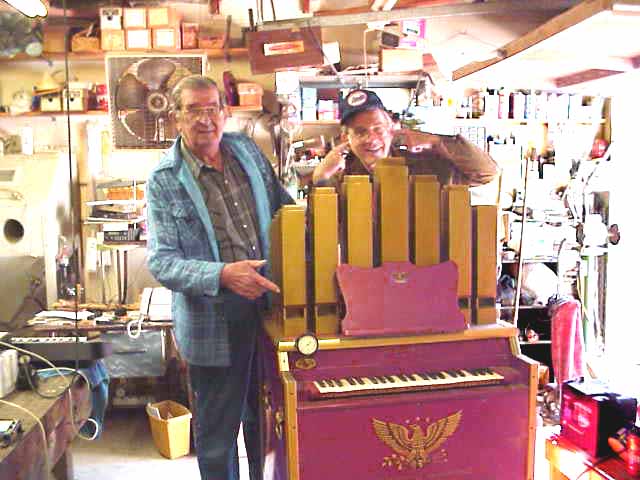 Paul Freiling, left, with Robbie Rhodes. When I learned the price
of brass tubing I changed my plans and instead built the whistles of maple
wood. The pressure is 1 psi, or about 28 inches water column.
Some organ guys can't believe it, but that's typical for an outdoor air
calliope!
Paul Freiling, left, with Robbie Rhodes. When I learned the price
of brass tubing I changed my plans and instead built the whistles of maple
wood. The pressure is 1 psi, or about 28 inches water column.
Some organ guys can't believe it, but that's typical for an outdoor air
calliope!
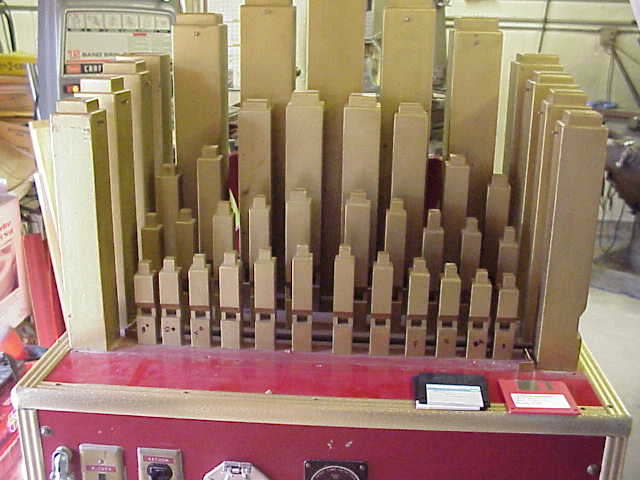 Inside the cabinet is
Inside the cabinet is
230 feet of hose, from 5/8" down to 5/32",
30 feet of copper plumbing pipe,
48 feet of select Maple (pipes),
43 each of copper elbows, pipe nipples, jam nuts,
16 feet of 3/8" copper tubing,
30 feet of 6-32 threaded rod,
25 feet of aluminum channel,
120 feet of 3/16" stainless welding rod (pull-rods from pneumatics
to keys),
2 industrial vacuum motors.
The whistle base and the tuning plug were made from one piece
of wood, milled flat and then sawn into two pieces. I just made the
cross section area the same as the old Tangley whistles, and then adjusted
the other dimensions for a nice sound.
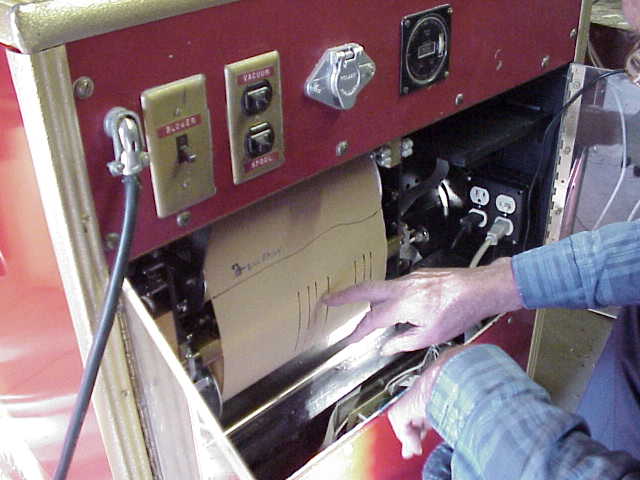 At
the rear of the cabinet is the spool frame which plays calliope A-rolls,
and also a Devtronics MIDI receiver so that MIDI disk files of calliope
tunes can be played. The instrument has 43 whistles, beginning at
F below middle C, the same as a CA43 Tangley. The tracker bar is
tubed to Wurlitzer unit valves, which operate individual pneumatics, which
in turn pull down the keys, which opens a poppet valve to the pipes. At
the rear of the cabinet is the spool frame which plays calliope A-rolls,
and also a Devtronics MIDI receiver so that MIDI disk files of calliope
tunes can be played. The instrument has 43 whistles, beginning at
F below middle C, the same as a CA43 Tangley. The tracker bar is
tubed to Wurlitzer unit valves, which operate individual pneumatics, which
in turn pull down the keys, which opens a poppet valve to the pipes.
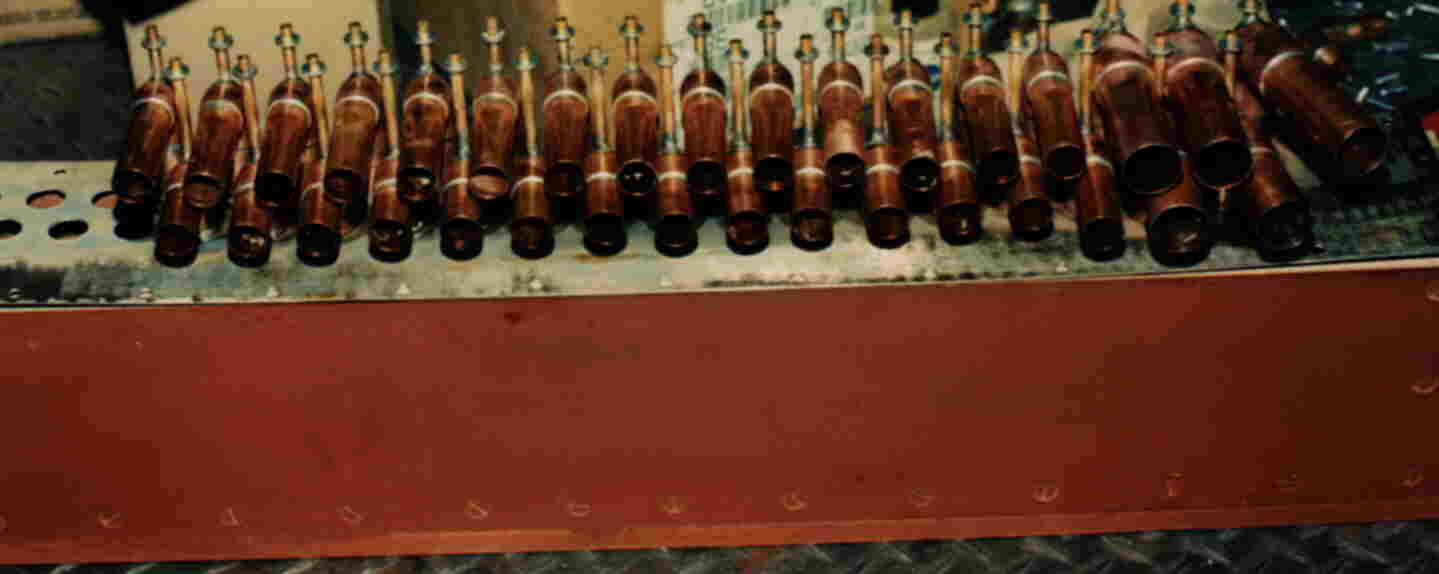 The shaft
of the poppet valve goes vertically down the inside of the copper elbow.
A short length of smaller copper tubing is soldered into the elbow to support
the valve stem. The photo shows each valve stem with a compression
spring and lock nuts, and a leather nut on top which the keys set upon. The shaft
of the poppet valve goes vertically down the inside of the copper elbow.
A short length of smaller copper tubing is soldered into the elbow to support
the valve stem. The photo shows each valve stem with a compression
spring and lock nuts, and a leather nut on top which the keys set upon.
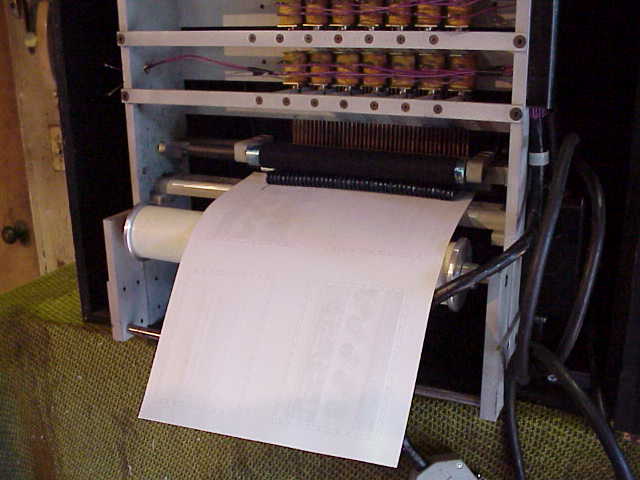 Several
years ago I designed and built a printer that fits on the rear of the Calliope.
The recording machine prints a blue line on the blank paper roll when a
key is played. Tiny knurled wheels normally press gently against
the inked roller above them; when a key is pressed a solenoid moves
the inked wheel into contact with the paper. Several
years ago I designed and built a printer that fits on the rear of the Calliope.
The recording machine prints a blue line on the blank paper roll when a
key is played. Tiny knurled wheels normally press gently against
the inked roller above them; when a key is pressed a solenoid moves
the inked wheel into contact with the paper.
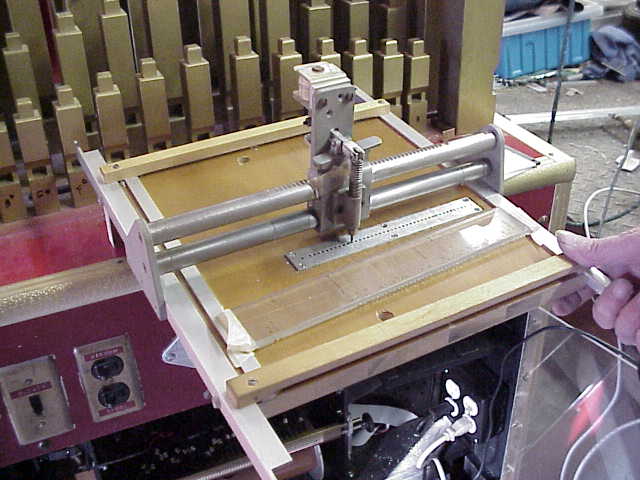 I
built this little frame punch to punch holes in the paper which was marked
by the roll recording machine. The solenoid operates when a foot
pedal is depressed, with the current controlled by a motor-driven rotary
interrupter. I added the interrupter because my ankle was getting
tired from pushing the pedal for every punch. But after punching
several rolls, I decided that going electronic might be easier. I
built this little frame punch to punch holes in the paper which was marked
by the roll recording machine. The solenoid operates when a foot
pedal is depressed, with the current controlled by a motor-driven rotary
interrupter. I added the interrupter because my ankle was getting
tired from pushing the pedal for every punch. But after punching
several rolls, I decided that going electronic might be easier.
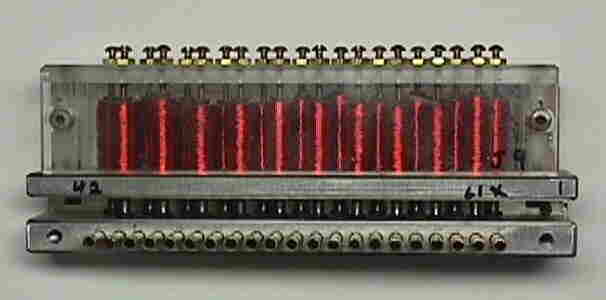 I
made the MIDI system myself. I wound 12-volt coils in two banks of
21 notes, and teed them into the tubes from the tracker bar. The solenoids
pull a plunger away from an opening to let air into the tube. That
way I can use either system, A-roll or MIDI. I
made the MIDI system myself. I wound 12-volt coils in two banks of
21 notes, and teed them into the tubes from the tracker bar. The solenoids
pull a plunger away from an opening to let air into the tube. That
way I can use either system, A-roll or MIDI.
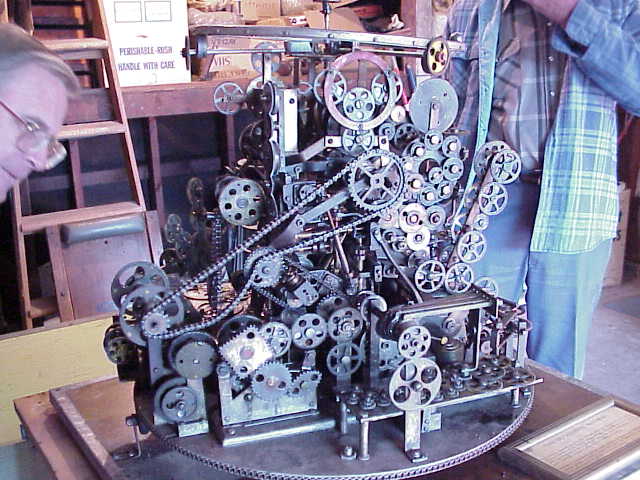 The
marvelous "Do-Nothing Machine". Out of view on the back side is a
small electric gear motor which slowly drives the plywood turntable, while
another electric motor or two turns everything else. Deep inside
the tightly packed collection of assorted shafts and gears is the remains
of a Norden bomb sight from World War 2, and the rest just grew and grew!
It was built from 1946 to 1952 by Lawrence F. Walstrom, Los Angeles, California.
With over 750 gears, chains, etc., it accomplishes absolutely nothing!
I wrote this article following several years ago to explain it. The
marvelous "Do-Nothing Machine". Out of view on the back side is a
small electric gear motor which slowly drives the plywood turntable, while
another electric motor or two turns everything else. Deep inside
the tightly packed collection of assorted shafts and gears is the remains
of a Norden bomb sight from World War 2, and the rest just grew and grew!
It was built from 1946 to 1952 by Lawrence F. Walstrom, Los Angeles, California.
With over 750 gears, chains, etc., it accomplishes absolutely nothing!
I wrote this article following several years ago to explain it.
The Do-Nothing Machine
This Machine, which is undoubtedly the most complex assemblage of
Bicuspidary discs, was designed either by Government Engineers, or a committee,
which is why as you see it, it goes nowhere, and does nothing. It was originally
designed as a striking mechanism for a mantle clock, but it seems to have
gotten carried away, with delusions of grandeur.
The three electrically powered motive forces, are gravitationally
free, non-synchronal, trapezoidal seclusion wound, and in the Delta configuration.
This of course prevents total flocture in case of power failure during
critical lunar phases. In the event this happens, the operator must search
rapidly, and diligently to find the cause of the escaping electrons, so
that there is not an excess of stray electrons massing in the immediate
area, which would tend to create some inaudible sounds toward the lower
brackets.
The spherical metal mass orbiting in the redundantly circular raceway,
is advanced rearward, due to the three epicyclic framatoidal cams, which
are timed in sequential order.
Due to the inherent possibility during startup, of exceeding the
Torsional Modulus of Elasticity, from the Polar Moment of Inertia, prior
to final assembly, all shafts, except those which were castellated, were
Frenelized in an uncontrolled Hydrostatic atmosphere to the equivalent
of maximum kilopascals on the circumareolar scale.
There are 764 gears of all types, connected to each other, either
by tooth, chain, shaft or otherwise, all going round and round, for the
sole purpose of viewing by people who have nothing else to do, but watch
it go round and round.
Paul E. Freiling
Fullerton, California
email: pefreiling@sbcglobal.net
06 Dec 1998, 04 June 2001, 6 Sept. 2006
|
 Gallery
Gallery
 Calliope
Calliope
 freiling
freiling
 I was born in April 1921 and raised in Hannibal, Missouri, on the Mississippi
River. I grew up hearing the Streckfuss excursion boats playing the calliopes
(steam, of course), and also, being somewhat of a circus buff, have always
loved the sounds of calliopes. Several years ago, not being financially
able to buy one, I decided that I could build one. I am a retired machinist,
with a shop in my back yard, where I can make about anything I take a notion
to. I really didn't know quite what I was doing, but I learned as
I went. It's a long story, but it came out very well.
I was born in April 1921 and raised in Hannibal, Missouri, on the Mississippi
River. I grew up hearing the Streckfuss excursion boats playing the calliopes
(steam, of course), and also, being somewhat of a circus buff, have always
loved the sounds of calliopes. Several years ago, not being financially
able to buy one, I decided that I could build one. I am a retired machinist,
with a shop in my back yard, where I can make about anything I take a notion
to. I really didn't know quite what I was doing, but I learned as
I went. It's a long story, but it came out very well.
 Paul Freiling, left, with Robbie Rhodes. When I learned the price
of brass tubing I changed my plans and instead built the whistles of maple
wood. The pressure is 1 psi, or about 28 inches water column.
Some organ guys can't believe it, but that's typical for an outdoor air
calliope!
Paul Freiling, left, with Robbie Rhodes. When I learned the price
of brass tubing I changed my plans and instead built the whistles of maple
wood. The pressure is 1 psi, or about 28 inches water column.
Some organ guys can't believe it, but that's typical for an outdoor air
calliope!
 Inside the cabinet is
Inside the cabinet is
 At
the rear of the cabinet is the spool frame which plays calliope A-rolls,
and also a Devtronics MIDI receiver so that MIDI disk files of calliope
tunes can be played. The instrument has 43 whistles, beginning at
F below middle C, the same as a CA43 Tangley. The tracker bar is
tubed to Wurlitzer unit valves, which operate individual pneumatics, which
in turn pull down the keys, which opens a poppet valve to the pipes.
At
the rear of the cabinet is the spool frame which plays calliope A-rolls,
and also a Devtronics MIDI receiver so that MIDI disk files of calliope
tunes can be played. The instrument has 43 whistles, beginning at
F below middle C, the same as a CA43 Tangley. The tracker bar is
tubed to Wurlitzer unit valves, which operate individual pneumatics, which
in turn pull down the keys, which opens a poppet valve to the pipes.
 The shaft
of the poppet valve goes vertically down the inside of the copper elbow.
A short length of smaller copper tubing is soldered into the elbow to support
the valve stem. The photo shows each valve stem with a compression
spring and lock nuts, and a leather nut on top which the keys set upon.
The shaft
of the poppet valve goes vertically down the inside of the copper elbow.
A short length of smaller copper tubing is soldered into the elbow to support
the valve stem. The photo shows each valve stem with a compression
spring and lock nuts, and a leather nut on top which the keys set upon.
 Several
years ago I designed and built a printer that fits on the rear of the Calliope.
The recording machine prints a blue line on the blank paper roll when a
key is played. Tiny knurled wheels normally press gently against
the inked roller above them; when a key is pressed a solenoid moves
the inked wheel into contact with the paper.
Several
years ago I designed and built a printer that fits on the rear of the Calliope.
The recording machine prints a blue line on the blank paper roll when a
key is played. Tiny knurled wheels normally press gently against
the inked roller above them; when a key is pressed a solenoid moves
the inked wheel into contact with the paper.
 I
built this little frame punch to punch holes in the paper which was marked
by the roll recording machine. The solenoid operates when a foot
pedal is depressed, with the current controlled by a motor-driven rotary
interrupter. I added the interrupter because my ankle was getting
tired from pushing the pedal for every punch. But after punching
several rolls, I decided that going electronic might be easier.
I
built this little frame punch to punch holes in the paper which was marked
by the roll recording machine. The solenoid operates when a foot
pedal is depressed, with the current controlled by a motor-driven rotary
interrupter. I added the interrupter because my ankle was getting
tired from pushing the pedal for every punch. But after punching
several rolls, I decided that going electronic might be easier.
 I
made the MIDI system myself. I wound 12-volt coils in two banks of
21 notes, and teed them into the tubes from the tracker bar. The solenoids
pull a plunger away from an opening to let air into the tube. That
way I can use either system, A-roll or MIDI.
I
made the MIDI system myself. I wound 12-volt coils in two banks of
21 notes, and teed them into the tubes from the tracker bar. The solenoids
pull a plunger away from an opening to let air into the tube. That
way I can use either system, A-roll or MIDI.
 The
marvelous "Do-Nothing Machine". Out of view on the back side is a
small electric gear motor which slowly drives the plywood turntable, while
another electric motor or two turns everything else. Deep inside
the tightly packed collection of assorted shafts and gears is the remains
of a Norden bomb sight from World War 2, and the rest just grew and grew!
It was built from 1946 to 1952 by Lawrence F. Walstrom, Los Angeles, California.
With over 750 gears, chains, etc., it accomplishes absolutely nothing!
I wrote this article following several years ago to explain it.
The
marvelous "Do-Nothing Machine". Out of view on the back side is a
small electric gear motor which slowly drives the plywood turntable, while
another electric motor or two turns everything else. Deep inside
the tightly packed collection of assorted shafts and gears is the remains
of a Norden bomb sight from World War 2, and the rest just grew and grew!
It was built from 1946 to 1952 by Lawrence F. Walstrom, Los Angeles, California.
With over 750 gears, chains, etc., it accomplishes absolutely nothing!
I wrote this article following several years ago to explain it.